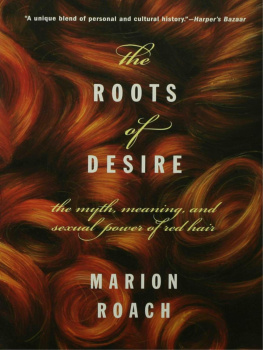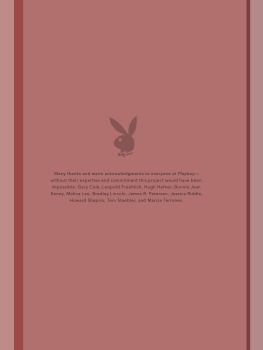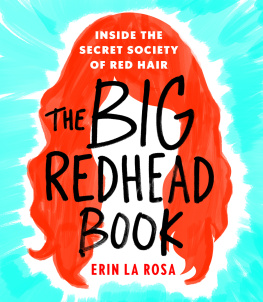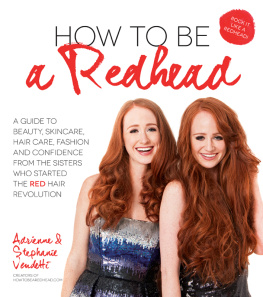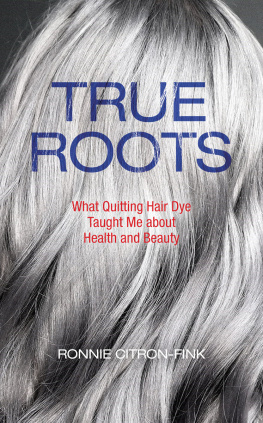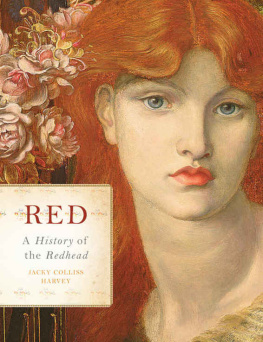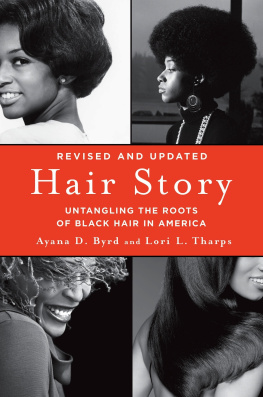THE ROOTS OF DESIRE
BY THE SAME AUTHOR
Another Name for Madness
Dead Reckoning: The New Science of Catching Killers
(with Michael Baden, M.D.)
THE ROOTS
OF DESIRE
The Myth, Meaning, and Sexual
Power of Red Hair
MARION ROACH
BLOOMSBURY
Copyright 2005 by Marion Roach
All rights reserved. No part of this book may be used or reproduced in any manner
whatsoever without written permission from the publisher except in the case of brief
quotations embodied in critical articles or reviews. For information address
Bloomsbury USA, 175 Fifth Avenue, New York, NY 10010.
"Red Headed Woman" by Bruce Springsteen. Copyright 1990 Bruce Sprinsteen
(ASCAP). Reprinted by permission. International copyright secured. All rights reserved.
"Smoke and Steel" from Smoke and Steel by Carl Sandburg, copyright 1920 by
Harcourt, Inc. and renewed 1948 by Carl Sandburg, reprinted by permission of the
publisher.
Every attempt has been made to contact copyright holders of quoted material; in the
event of an inadvertent omission or error, please contact the publisher.
Published by Bloomsbury USA, New York
Distributed to the trade by Holtzbrinck Publishers
All papers used by Bloomsbury USA are natural, recyclable products made from
wood grown in well-managed forests. The manufacturing processes conform to the
environmental regulations of the country of origin.
The Library of Congress has cataloged the hardcover edition of this book as follows:
Roach, Marion.
The roots of desire : the myth, meaning, and sexual power of red hair /
Marion Roach.1st U.S. ed.
p. cm.
Includes bibliographical references and index.
eISBN: 978-1-59691-894-8
1. Redheads. 2. HairSocial aspects. 3. HairErotic aspects. I. Title.
GT6735.R63 2005
391.5dc22
2005040963
First published in the United States by Bloomsbury in 2005
This paperback edition published in 2006
1 3 5 7 9 10 8 6 4 2
Typeset by Hewer Text UK Ltd, Edinburgh
Printed in the United States of America
by Quebecor World Fairfield
For Rex, simple as that
CONTENTS
I WROTE THIS BOOK after a tale I was told turned lurid. Not lurid at the start; at first the story was of minor interest to me. At its beginning it was a simple rendering of scientific discovery, a relatively by-the-book identification of a genetic marker told to me during the time of the mapping of the whole human genome. The story seemed small, one of many such discoveries, and this particular genetic discovery did not appear to lead to cures or breakthroughs, to serums, prizes, or famethose being the usual standards required to pique a layperson's attention. And then there was the fact that in real time, the discovery was old news.
It was 1995 when a shy scientist in Edinburgh had discovered the gene for red hair. Following up on the work of others, he had advanced some pigmentary genetic research performed on mice and applied it to humans. And striking as red hair can be, what he had found was the clue to the hair color of fewer than 4 percent of the world's population.
Seven years passed before I read about the discovery. But when I did, I called Jonathan Rees, the man whose lab had done the investigative work on the gene. And even he seemed weary, his tone suggesting that there might be nothing more to say. Perhaps it had all been told, I suggested, politely making an effort to excuse myself from further interest. "No," he countered. Quite the opposite. Read the press he had gotten, he recommended, and see if anything pops out at you. It sounded like he had given this advice before. I wondered if his weariness resulted from that lead not being taken.
The armful of worldwide newspaper and magazine accounts of Rees's discovery are more soft porn than science. Tipped toward the seductive, inclined like the proverbial guys outside peep shows who beckon you inside, they are mottled with references to the highest-priced Roman female slaves, Vikings raping their way across the Northern Hemisphere, and erotic escapades of redheads from Eve to Rita. The stories were engorged with a sexual energy I had never seen before in plain tales of scientific discovery. And suddenly I was in love with the tale. But which tale? That of the science or that lustier one of the popular notions?
In 2002, the Washington Post ran a feature piece on redheads, mentioning Rees's work, pining, "Why do we want them so much now?" (insisting, thereby, that we do). The Atlanta Journal-Constitution, the Cincinnati Enquirer, and Gannett News Service offered features by writers who had colored their hair red in part to report on what they claimed was a huge surge in the worldwide purchase of the at-home coloring processes that delivered the hueas well as the allureof red hair. It was quickly followed by a United Kingdom news service piece stating that Scotland's redheads are more sexually attractive than redheads anywhere else in the world. That, I had to see.
In my research, I learned that in every culture of the world, in every recorded epoch, there was a strong reaction to those who carry the melanocortin receptor gene, known as MC1R, on their sixteenth chromosome. The pathology of beliefs we harbor as well as the totems of popular culture created about this hair color have struck every emotion in our hearts, from vehement terror to unthrottled lust, since the hue first appeared in humankind, some fifty thousand years ago.
Adam is said to have had a first wife who was a redhead, though Eve, wife number two, is also frequently depicted wearing nothing but her long red hair. Judas Iscariot is painted as a redhead, as is Mary Magdalene. In Greek mythology, redheads turn into vampires when they die. During the Spanish Inquisition, flame-colored hair was evidence enough that its wearer had nicked hell's fire and therefore had to be burned as a witch. An 1886 book by Augustin Galopin noted redheads as the strongest scented of all women. I learned that a person could be beaten "like a red-headed stepchild"; that, in 1912, phrenology revealed redheads make the best waitresses; that Hitler reportedly banned the intermarriage of redheads for fear of "deviant offspring"; that a Corsican proverb has you spit after passing a redhead; and that, in the words of an American political pollster, "You can't sell one on television. They look fickle."
Fickle? My mother used to call me fickle. She said it traveled with my hair color. I prefer to think of myself as passionate and pursuits such as this book to be the spawn of curiosity. But I get red in the face with anger at "fickle." Hearing the word of the pollster shot me to that place of stored memory, that smudge of where we really come from, and out flew taunts of children on the playground, softened amid the register of phrases divulged in intimate and astonished passion or shouted by men on the street in various countries, most particularly my ownand they all were, in fact, about my color.
Something clicked in my mind when the tale was colorized from that of a genetic pigmentary marker to one of sex. It almost seemed like two separate stories. Or was it that the worldwide press had thought we wouldn't be interested in the scientific without these allusions to the sexual? Was it possible that the erotic tidbits are in fact as much a part of the history of the world of red hair as, say, freckles?
What is on this gene, anyway?
I called back Jonathan Rees in Edinburgh. He suggested I read the criticism of the human genome project by James Watson, corecipient of the Nobel Prize for his discovery of the structure of DNA. In it, Watson suggests that those, like Rees, who are interested in the genome for reasons other than profit must button up their lab coats and go digging for the stuff they want because most other scientists won't bother. Little attention has been paid to the gene for pigments, whether it is for blond hair or black skin. And reading Watson's words reminded me that it had taken seven years for news of Rees's discovery to percolate up to me. Watson goes on to suggest that those sites on the genome that will bring fame and fortune will be explored and staked out with alacrity, but that those sites that do not appear to harbor the potential for huge drug company profits, like the gene for red hair, will be around for a while before anyone understands them. How odd, I thought: how little we really know about what makes us the colors by which we identify another and ourselves. And how unfortunate, as well, since what that leaves us are mere biases and myths when responding to the colors we are.
Next page
